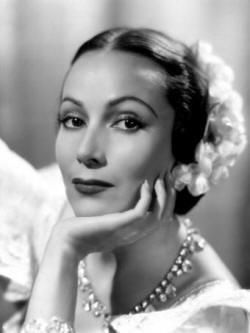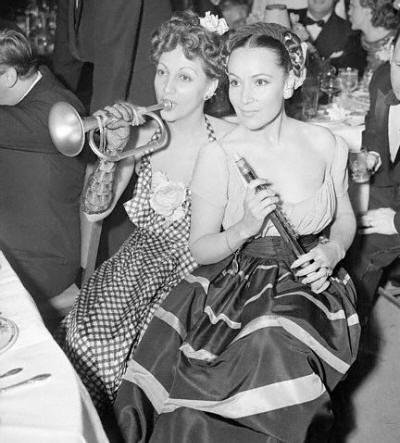Husband Cedric Gibbons
Queer Places:
C. Salvador Novo 127, Santa Catarina, Coyoacán, 04010 Ciudad de México, CDMX, Mexico
Panteón Civil de Dolores
Miguel Hidalgo, Miguel Hidalgo Borough, Distrito Federal, Mexico
 Dolores del Río (born María de los Dolores Asúnsolo y López-Negrete; 3 August 1904[1][2] – 11 April 1983) was a Mexican actress, dancer and singer.
She had affairs with Greta Garbo and
Billie Holiday. Lavender marriages
included those between MGM’s chief art director
Cedric Gibbons and Dolores del
Rio, or Edmund Lowe and Lilyan Tashman, or
Rudolph Valentino and
Jean Acker
(the lover of Grace Darmond and, at another time, of
Alla Nazimova), or
Janet
Gaynor (later the lover of Mary Martin) and costume designer
Adrian, or
Barbara Stanwyck and
Robert Taylor.
Dolores del Río (born María de los Dolores Asúnsolo y López-Negrete; 3 August 1904[1][2] – 11 April 1983) was a Mexican actress, dancer and singer.
She had affairs with Greta Garbo and
Billie Holiday. Lavender marriages
included those between MGM’s chief art director
Cedric Gibbons and Dolores del
Rio, or Edmund Lowe and Lilyan Tashman, or
Rudolph Valentino and
Jean Acker
(the lover of Grace Darmond and, at another time, of
Alla Nazimova), or
Janet
Gaynor (later the lover of Mary Martin) and costume designer
Adrian, or
Barbara Stanwyck and
Robert Taylor.
With a career spanning more than 50 years, Dolores del Río is regarded as the first major female Latin American crossover star in Hollywood,[3][4][5][6] with an outstanding career in American cinema in the 1920s and 1930s. She was also considered one of the most important female figures in the Golden Age of Mexican cinema.[7] Del Río is also remembered as one of the most beautiful faces on screen of all time.[6]
After being discovered in Mexico, she began her film career in Hollywood in 1925. She had roles on a string of successful films, including Resurrection (1927), Ramona (1928) and Evangeline (1929). Del Río came to be considered a sort of feminine version of Rudolph Valentino, a "female Latin Lover",[8][9] in her years during the American "silent" era.
With the advent of sound, she acted in a range of film genres, from contemporary crime melodramas to musical comedies and romantic dramas. Among her most successful films of that decade include Bird of Paradise (1932), Flying Down to Rio (1933) and Madame Du Barry (1934). In the early 1940s, when her Hollywood career began to decline, Del Río returned to Mexico and joined the Mexican film industry, which at that time was at its peak.
When Del Río returned to her native country, she became one of the more important stars of the Golden Age of Mexican cinema. A series of Mexican films starring Del Rio, are considered classic masterpieces and helped boost Mexican cinema worldwide. Of them stands out the critically acclaimed María Candelaria (1943). Del Río remained active mainly in Mexican films throughout the 1950s. In 1960 she returned to Hollywood. During the next years she appeared in Mexican and American films. From the late 1950s until the early 1970s she also successfully ventured into theater in Mexico and appeared in some American TV series.
Del Río is now considered a mythical figure of American and Mexican cinema, and a quintessential representation of the female face of Mexico in the world.[10]

Ann Page and Dolores del Rio

Hollywood Walk of Fame
One of the best-documented gay bachelor homes was the luxurious residence of
flamboyant poet and columnist Salvador Novo in suburban Coyoacan.With neighbours
that included the deposed Romanian King Carol II and film diva
Dolores del Río, Novo maintained a respectable bourgeois facade. Born in 1904 to
Andres Novo, a Spanish immigrant grocer, and Amelia Lopez, a middle-class Mexican
woman, Novo attended the National Prep School in the late 1910s and early 1920s.
His instructors recognised his talents, and promoted his ascent into the bureaucracy.
Throughout his youth, he lived with his widowed mother and family in various homes
in middle-class neighbourhoods. By age twenty, Novo often shared studios with other
gays, escaping from his family to write and to have anonymous sexual encounters with
cadets, taxi drivers and bus drivers. In his Plaza de San Diego studio, the voracious
Novo had sex with as many as eight men over the course of one afternoon and evening
of September 1934. The studio demanded significant work from Novo, who prepared
trays of sandwiches, arranged flowers and fluffed pillows before donning silken robes
to await his beaus’ arrival. These relationships left him spiritually bereft, and so, when
he fell in love in 1934, his attention turned towards domesticity.
In 1978, Dolores del Río was diagnosed with osteomyelitis, and in 1981 she was diagnosed with hepatitis B following a contaminated injection of vitamins.[75] She also suffered from arthritis.[75] In 1982, del Río was admitted to Scripps Hospital, La Jolla, California, where hepatitis led to cirrhosis.[82]
On April 11, 1983, Dolores del Río died from liver failure at the age of 78, in Newport Beach, California.[83] It is said that the day she died, an invitation to attend the Oscars was sent to her.[75][82] After dying, she was cremated and her ashes were moved from the United States to Mexico where they were buried at the Panteón de Dolores in Mexico City, Mexico,[75] specifically on The Rotunda of Illustrious Persons.[84]
My published books:

BACK TO HOME PAGE

 Dolores del Río (born María de los Dolores Asúnsolo y López-Negrete; 3 August 1904[1][2] – 11 April 1983) was a Mexican actress, dancer and singer.
She had affairs with Greta Garbo and
Billie Holiday. Lavender marriages
included those between MGM’s chief art director
Cedric Gibbons and Dolores del
Rio, or Edmund Lowe and Lilyan Tashman, or
Rudolph Valentino and
Jean Acker
(the lover of Grace Darmond and, at another time, of
Alla Nazimova), or
Janet
Gaynor (later the lover of Mary Martin) and costume designer
Adrian, or
Barbara Stanwyck and
Robert Taylor.
Dolores del Río (born María de los Dolores Asúnsolo y López-Negrete; 3 August 1904[1][2] – 11 April 1983) was a Mexican actress, dancer and singer.
She had affairs with Greta Garbo and
Billie Holiday. Lavender marriages
included those between MGM’s chief art director
Cedric Gibbons and Dolores del
Rio, or Edmund Lowe and Lilyan Tashman, or
Rudolph Valentino and
Jean Acker
(the lover of Grace Darmond and, at another time, of
Alla Nazimova), or
Janet
Gaynor (later the lover of Mary Martin) and costume designer
Adrian, or
Barbara Stanwyck and
Robert Taylor. 


